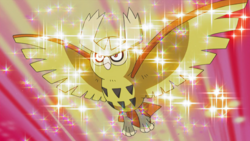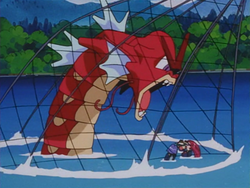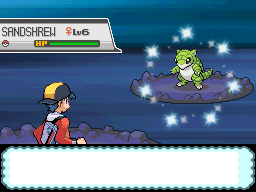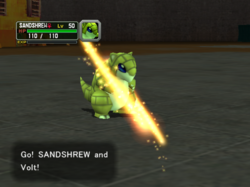Shiny Pokémon
| This article is a featured article candidate. There may be ongoing discussion on the talk page. |

A Shiny Pokémon (Japanese: 色違い differently colored or 光る shining), also recognized as alternate coloration or rare coloration, is a specific Pokémon with different coloration to what is usual for its species. It is one of the many differences that a Pokémon can have within its species.
The term "Shiny Pokémon" was first created by fans to refer to the sparkling sound effect and animation made at the start of an encounter with one in the games. Eventually, this term fell into official usage in Generation IV, used on promotional material promoting Shiny event Pokémon. The term Shiny Pokémon was first used in-game in Pokémon Black and White in Nimbasa City.
Shiny Pokémon can differ in color from their normal counterparts very little or very much. Some Pokémon, such as Glaceon or Pichu, have a Shiny coloration only a few shades darker or lighter in color. However, many Pokémon have a spectacular difference between their normal and Shiny variations; even extremely common Pokémon like Caterpie show a dramatic difference. An evolutionary line is not necessarily guaranteed to have similar Shiny colorations even if their standard colorations are the same; both Ponyta and Rapidash have orange flames, but a Shiny Ponyta has blue flames while a Shiny Rapidash has gray flames (this is switched in Generation II). Sometimes, two Pokémon in an evolutionary line with different standard colorations will have the same Shiny coloration, as in the case of Skitty and Delcatty.
Form differences, such as that of Shellos and Gastrodon, are not normal/Shiny variations of one another, but the individual forms can be Shiny.
In the main series games
| Gen II | Stadium 2 | Gen IIIFRLG | Gen IV | Gen V | Gen VI |
|---|---|---|---|---|---|
In the main series, Shiny Pokémon were first introduced in Generation II. This was likely to take full advantage of the capabilities of the then-recent Game Boy Color.
When a Shiny Pokémon appears in the wild or is sent out of its Poké Ball, stars will briefly surround it and make a pinging sound effect (in Generation IV, this will also happen if a wild Shiny Pokémon breaks out of a Poké Ball). In Generation II, this ping happens before the Pokémon's cry, while from Generation III onward, the ping happens afterward. In Pokémon Stadium 2 and Pokémon Battle Revolution, a flash of light circles the Pokémon upon its release from the Poké Ball.
Shininess is inherent to an individual Pokémon; that is, a Pokémon that starts out Shiny will always be Shiny, and one that is not will never be. Upon evolution, a Pokémon will retain its Shiny status; for example, a Shiny Charmander, if leveled up, will eventually become a Shiny Charmeleon and then a Shiny Charizard, just as a regular Charmander will become a regular Charmeleon and then a regular Charizard.
On the Pokémon's status screen, a Pokémon Shiny status is indicated in Generation II as three small stars beside its gender, as a small yellow star in Pokémon FireRed and LeafGreen, in Pokémon Stadium 2 as a yellow star that is animated dimming and brightening continuously, and in Generations IV and V as a large star near its picture. In Pokémon Ruby, Sapphire, and Emerald, the Pokémon's Pokédex number will be colored gold instead of white, whereas in Generations IV and V, the number will be colored red. In Pokémon Ruby, Sapphire, and Emerald, the background behind the sprites of Shiny Pokémon is white instead of gray, and small purple squares are added to the corners. In Pokémon FireRed and LeafGreen, the border with gender, nickname, and level will be teal instead of purple.
Generation II
In Generation II, Shininess is determined by the IVs of a Pokémon. If a Pokémon's Speed, Defense, and Special IVs are all 10, and its Attack IV is 2, 3, 6, 7, 10, 11, 14 or 15, it will be Shiny. Using IVs instead of some other value to determine Shininess allowed for compatibility with Generation I, as if a Shiny Pokémon is traded back, then traded forward, it would retain its Shininess. Shiny Pokémon are above average in terms of IVs, but only slightly.
Due to the HP IV being determined by the other four IVs, a Shiny Pokémon's HP IV can only be either 0 or 8.
In a wild encounter, the probability of a Pokémon's IVs lining up in any of the above manners is 1/8192; breeding has different odds due to parents passing on IVs to their offspring. For example, if one breeds a Shiny Pokémon properly, the offspring may have as high as a 1/64 chance of being Shiny, depending on the species of Pokémon.
To highlight alternate coloration, a red Gyarados at the Lake of Rage is part of the plot of the Generation II games and their remakes. After its defeat or capture, a Red Scale will be obtained, which can be given to Mr. Pokémon in exchange for an Exp. Share. The red Gyarados can be found at level 30.
The Pokémon that hatches from the Odd Egg in Crystal has a 14% chance of the result being Shiny in localized games, and a 50% chance in Japanese games.[1]
Generation III
In Generation III, most of the data structures were completely overhauled. Starting from this generation, a Pokémon's Shininess is no longer linked to any of its other stats. Instead, Shininess is determined by a calculation involving the Original Trainer's ID number and secret ID number, as well as the Pokémon's personality value.
Technically, the formula used is (TrainerID xor SecretID) xor (PersonalityValue>>16 xor (PersonalityValue mod 65536)); the latter two values represent the first 16 and last 16 bits of the 32-bit personality value, respectively. More detailed information can be found at the personality value article.
The above formula can result in a number from 0 to 65535. If the result is less than 8, then the Pokémon is Shiny. This gives an overall probability of 8/65536 or 1/8192, exactly the same as in Generation II.
In this generation, several Pokémon Battle e Trainers have Pokémon which are preset as Shiny. Additionally, in the Trainer Tower in Pokémon FireRed and LeafGreen, there are three Trainers who have preset Shiny Pokémon: the Trainer on the seventh floor in the Single Battle mode has a Shiny Meowth, the pair of Trainers on the first floor in the Double Battle mode have a Shiny Espeon, and finally, the second Trainer on the fourth floor in the Knockout Mode has a Shiny Seaking. No Trainers have preset Shiny Pokémon in the Mixed Mode.
Generation IV
This generation first introduced methods of increasing the Shiny probability above the minimal 1/8192. If a long chain is created with the Poké Radar, the Shiny probability can increase up to as high as 1/200 with a chain of 40 or higher. Additionally, breeding two Pokémon with different countries of origin (dubbed the Masuda method) multiplies the chance of receiving a Shiny Egg by 5, resulting in a 5/8192 (approximately 1/1638) probability.
In the Veilstone Game Corner, in the bonus round on the slot machines, a Clefairy appears on the lower screen. There are three kinds of Clefairy: a Ditto that has transformed into a Clefairy, a normal Clefairy, and a Shiny Clefairy. Shiny Clefairy are the rarest and last for the most bonus rounds, but are not as rare as encountering an actual wild Shiny Pokémon.
In Pokémon HeartGold and SoulSilver, the red Gyarados makes its return as a plot point. Shiny Pokémon also appear in their Shiny state as walking Pokémon when they follow the player.
Generation V
Starting from this generation, Pokémon in the Pokédex will appear Shiny if the first specimen of that Pokémon encountered is Shiny.
This generation was the first to include checks that prevent certain wild Pokémon from being Shiny. These include wild Reshiram, Zekrom and Victini as well as any Pokémon obtained from the Dream World. However, like all Pokémon, Reshiram, Zekrom, and Victini still have Shiny palettes programmed in the games' data.
The Poké Radar no longer exists in this generation, but the probability of obtaining a Shiny Egg from the Masuda method has increased, from 5/8192 to 6/8192 (approximately 1/1638 to 1/1365).
In Pokémon Black 2 and White 2, as a reward for seeing every non-event Pokémon in the New Unova Pokédex, the player can receive a Permit that allows them to travel to the Nature Preserve, where they can encounter a level 60 Shiny Haxorus. Also, after defeating Benga in the Black TowerB2 or White TreehollowW2, he will give the player a level 5 Shiny GibleB2 or Shiny DratiniW2.
As an additional reward for catching every single non-event Pokémon in the National Pokédex, the player can receive the Shiny Charm from Professor Juniper. Having this item in the Bag increases the chance of obtaining a Shiny Pokédex by a flat 2/8192, resulting in a 3/8192 chance (about 1/2731) of finding one normally (an effectively tripled chance) and an 8/8192 chance (1/1024) of hatching one through the Masuda method.
Generation VI
This generation slightly changed how Shiny Pokémon are determined. While the basic formula is still identical to Generation III and all games since then, the value the formula returns now only has to be less than 16 to result in a Shiny, rather than less than 8. This results in a probability of 16/65536 or 1/4096, double the previous probability.
The Poké Radar returns in this generation after a generation of absence, and the Masuda method and Shiny Charm return as well. A new mechanic to increase the Shiny rate, consecutive fishing, was introduced. The exact rates at which the previous four techniques increase the Shiny probability are currently unknown.
Appearance

|
This section is incomplete. Please feel free to edit this section to add missing information and complete it. Reason: XD and Battle Revolution |
Unobtainable Shiny Pokémon
In most generations, there are a few Pokémon species that cannot be legitimately obtained Shiny. This can be caused by being impossible to obtain except through a direct event distribution, or by being programmed so that they cannot be Shiny in the wild (Generation V onward).
Generation II
Generation III and on
Generation IV and on
Generation V and on
Generation VI
Notes
- ↑ Mew distributed to Generation II games cannot be Shiny. All Mew distributed to Generation I games have a fixed set of IVs which do not match the requirements to be Shiny.[citation needed]
- ↑ Although it is legitimately possible to obtain a Shiny Jirachi from the Pokémon Colosseum Bonus Disc, it will not pass the Poké Transporter legality check and therefore is not available in this generation.[citation needed]
In the side series games
Pokémon Stadium
In Pokémon Stadium and Pokémon Stadium 2, Pokémon with a nickname can be colored slightly differently, whether or not they are actually Shiny. In the Ekans Hoop Hurl game in the Kids' Club, there are golden Diglett that are worth extra points.
In Stadium 2, there is an option while viewing the list to exclude any non-Shiny Pokémon from the listing (i.e. Group Color Pokémon/Cancel Color Pokémon). Here they are called Color Pokémon. This will show Shininess, even if the player is currently viewing a Generation I cartridge in the Lab.
Pokémon Colosseum

In Pokémon Colosseum, like in the main series games, Pokémon have a 1/8192 chance of being Shiny. Likewise, there is a 1/8192 chance of a Shadow Pokémon being Shiny; however, when a Shiny Shadow Pokémon is captured, it is highly improbable that the Pokémon will retain Shininess. Conversely, when an ordinary Shadow Pokémon is captured, there is still the 1/8192 chance of that Pokémon becoming Shiny when it is sent to the player's party or the Pokémon Storage System. Shininess is retained through purification. In Pokémon Colosseum, the color of a Shiny Pokémon can differ drastically from the handheld games.
Pokémon XD
In Pokémon XD, the game ensures that all Shadow Pokémon are not Shiny by recalculating the Pokémon personality value if it would result in a Shiny Pokémon. However, the starter Eevee, Mt. Battle Johto starter Pokémon, and Poké Spot Pokémon can be Shiny. As in Pokémon Colosseum, the color of a Shiny Pokémon can differ drastically from the handheld games. Shiny Pokémon have a different profile icon next to their health bar than their normally-colored counterparts.
My Pokémon Ranch
In My Pokémon Ranch, Pokémon's Shininess is visible. Pokémon traded by Hayley—except Phione and Mew—cannot be Shiny.
Pokémon Battle Revolution
In Pokémon Battle Revolution, Shiny Pokémon have face-sprites which show their Shininess. Random Pokémon in Colosseums can be Shiny, but have the same chance of being Shiny as wild Pokémon. This is due to the RNG, which generates a random PID.
In the spin-off games

|
This section is incomplete. Please feel free to edit this section to add missing information and complete it. Reason: more on Gates to Infinity Shinies |
Pokémon Mystery Dungeon: Explorers of Time, Darkness and Sky
In Pokémon Mystery Dungeon: Explorers of Time and Explorers of Darkness and Explorers of Sky, a Shiny Celebi appears, although Shiny Pokémon are not obtainable normally in the game.
Pokémon Mystery Dungeon WiiWare
In the Pokémon Mystery Dungeon games for WiiWare, Shiny Pokémon can be found in dungeons. Unlike the main series, only 36 different species of Shiny Pokémon are obtainable. The chances of finding one in a dungeon is the same chances as finding one in the wild in the main series. Unlike Shiny Pokémon in the past, however, the Shiny Pokémon found in these games have an added bonus: their Hunger stat is 200 as opposed to the 100 of normal Pokémon. A Red Gyarados can also be obtained at Level 30 via Wonder Mail password, as a reference to the one found in the Johto-based games.
Pokémon Mystery Dungeon: Gates to Infinity
In Pokémon Mystery Dungeon: Gates to Infinity, at least Ho-Oh can be encountered as a Shiny Pokémon. Should this happen, it will use different moves and be more powerful overall.
Super Smash Bros.
In the Super Smash Bros. series, Mewtwo, Squirtle, Ivysaur, Charizard, and Lucario each have several different colorations exclusive to the series. One of Pikachu's alternate colorations is its Shiny coloration wearing Red's hat, and one of Jigglypuff's is its Shiny coloration wearing a straw hat; however, all other playable Pokémon in the series, except Mewtwo, do not have their actual Shiny coloration as an alternate coloration.
Pokémon Rumble
In Pokémon Rumble, Shiny Pokémon may rarely appear. They will always tip over when defeated. The chances of their appearance are unconfirmed, although they appear to occur more often than in the main series. Shiny Pokémon are always given a special trait, a blue name in menus, and a star below their picture on the Collection screen. Some Shiny Pokémon can be obtained by the use of passwords.
Pokémon Rumble Blast
In Pokémon Rumble Blast, Shiny Pokémon have been removed entirely.
Pokémon Rumble U
Shiny Pokémon make their return to the Rumble series in Pokemon Rumble U and function similarly to how they did in the original Pokemon Rumble.
Pokémon Conquest
A Shiny Rayquaza is featured in Pokémon Conquest, sharing a Perfect Link with Nobunaga. Nobunaga's Black Rayquaza was distributed over Wi-Fi for Japanese Black and White players to commemorate the release of the game.
In the TCG
Shiny Pokémon have appeared in the TCG as well, first as Shining Pokémon in Neo Revelation and Neo Destiny, and later as Pokémon ![]() in EX Team Rocket Returns - EX Power Keepers. Players can only have one Pokémon
in EX Team Rocket Returns - EX Power Keepers. Players can only have one Pokémon ![]() per deck. The Stormfront, Platinum, Supreme Victors and Arceus sets include three cards each with alternate coloration artwork and a reverse holo effect, but are not classified as an entirely separate rarity. Unlike Shining Pokémon and Pokémon
per deck. The Stormfront, Platinum, Supreme Victors and Arceus sets include three cards each with alternate coloration artwork and a reverse holo effect, but are not classified as an entirely separate rarity. Unlike Shining Pokémon and Pokémon ![]() , these newest alternate coloration cards are not limited by special gameplay and deckbuilding rules, and since the names of the cards are not changed to indicate the alternate coloration, they can be evolved into non-Shiny Stage 1 Pokémon, or, in the case of Shiny evolved Pokémon, from normal Basic Pokémon.
, these newest alternate coloration cards are not limited by special gameplay and deckbuilding rules, and since the names of the cards are not changed to indicate the alternate coloration, they can be evolved into non-Shiny Stage 1 Pokémon, or, in the case of Shiny evolved Pokémon, from normal Basic Pokémon.
Shiny versions of several legendary Pokémon were also featured in the Call of Legends expansion as secret rares under the SL numbering subset.
From Black and White onward, all secret cards depict Pokemon in their Shiny colorations with the exception of Meowth.
List of cards with Shiny Pokémon
In the anime

|
This article contains old or outdated information, or has not been updated in a while. Please check the content of this article and update it as required. Reason: Clair's Shinny Druddigon animation (about 19 and half of minute into episode). |

- Main article: List of alternately colored Pokémon in the anime
Although the games had not premiered alternate colored Pokémon until Generation II, several Pokémon seen beforehand were colored differently. One such example is the pink Butterfree, the mate of Ash's Butterfree, which appeared as early as the twenty-first episode. This is, however, not the standard alternate coloration for a Butterfree, causing many to not count it. Likewise, the first appearance of a Generation III Pokémon in The Kecleon Caper featured a non-standard alternate colored Pokémon, this time a purple Kecleon. This may be due to Kecleon's Color Change Ability, however, similarly to the case in Pokémon Mystery Dungeon.
The first Pokémon with an alternate coloration that was seen was also the first Generation II Pokémon to appear, a Ho-Oh in the first episode. However, it is possible that it may not have been intended to be an alternate coloration, as Ho-Oh may not have been fully designed by the episode's release, and may have simply been colored after the version it represents, Pokémon Gold, and since alternate coloration was also not yet an explored concept. For these reasons, most do not consider this to be a Shiny Pokémon either.
In the Orange Archipelago, certain Pokémon have a different coloration because the climate is different than that of the mainland. For example, a Butterfree, instead of the normal white with black markings, would have gold wings with red spots on them.
A blue Breloom and a light-blue Marill also appeared in Weekend Warrior, which are not the official alternate colors for those Pokémon, and are possibly coloring errors.
The first true Shiny Pokémon that appeared, however, was a Noctowl in Fowl Play!. Ash eventually captured it, and, as in the games, sparkles surround it as it comes from its Poké Ball. Several other Shiny Pokémon have appeared later as well, often used to make them stand out more, or be the focus of an episode.
In Dealing With A Fierce Double Ditto Drama!, Narissa owns two Ditto, one of which is Shiny.
A Team Rocket mecha that appeared in Bagged Then Tagged!, the Digital Drapion, appears to be based on a Shiny Drapion.
The term was first used in Working on the Right Move!
In the manga
Because most manga series are published in black-and-white, Shiny Pokémon are few and far between. One major exception, because of its importance to the plot of Gold, Silver, Crystal, HeartGold, and SoulSilver is the red Gyarados.
In the Pokémon Adventures manga
In Pokémon Adventures's Gold, Silver & Crystal arc, Silver captured the raging leader of a group of Gyarados, who had been on a rampage since Team Rocket took control of the Goldenrod Radio Tower and sent out their evolution-inducing radio waves.
Crystal mentions that she caught a different colored Pineco as part of the Pokémon sent to Professor Oak in Off Course with Corsola.
Trivia
- In Generation III onwards, it is possible for an Egg to hatch Shiny on one game but not another. This is because Shininess is partially determined by the Original Trainer ID and Secret ID number. Eggs have the ID and SID of the game they were originally bred on, but change to the ID and SID of the hatcher immediately after hatching. It is this change that affects Shininess.
- Confusingly, this means that if a player hatches a traded Egg that would have been Shiny on the game it was originally bred on, it will appear Shiny on the hatching screen (since it still has the ID and SID of the original game), and then suddenly no longer be Shiny afterward (once it has obtained the ID and SID of the hatcher's game). Conversely, it is also possible for an newly hatched Egg to not appear Shiny on the hatching screen and then suddenly become Shiny afterward, if the Egg has been traded.
- While all (Generation III onward) event Eggs are set to prevent or force Shininess, if a player other than the one who obtained it from the event hatches the Egg, this prevention is bypassed, allowing an event Egg to hatch Shiny. This is the only way to obtain a Shiny Manaphy.
- Due to Shininess being determined by IVs in Generation II, several odd quirks arise:
- Since gender is also determined by IVs in Generation II, it is impossible to have a Shiny Pokémon with a gender ratio of seven males to one female that is female in those games, as the highest Attack IV a female Pokémon with a gender ratio of seven males to one female can have is 1, while the lowest Attack IV a Shiny Pokémon can have is 2.
- Since Unown's letter is also determined by IVs in Generation II, only Unown I and V can be Shiny.
- Since Hidden Power is determined by IVs, a Shiny Pokémon's Hidden Power type in Generation II can only be either Grass or Dragon, with a power of either 50 or 70.
- As Generation II does not allow two Pokémon to breed if they are likely to be from the same family, two Shiny Pokémon can never breed in Generation II.
- Pokémon Black 2 and White 2 have the most in-game event Shiny Pokémon available, with two.
- It is possible for the Minccino that appears in the "world of Pokémon" intro in Pokémon Black and White to be Shiny.
- It is possible for rental Pokémon found in the Battle Factory to be Shiny.
- It is also possible for the Pokémon that the old man encounters in FireRed and LeafGreen to be Shiny.
References

|
This game mechanic article is part of Project Games, a Bulbapedia project that aims to write comprehensive articles on the Pokémon games. |










